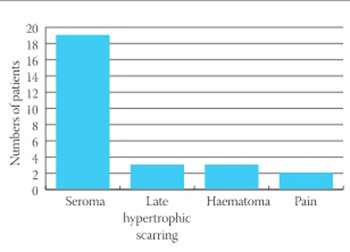Complications Following Autologous Latissimus Flap Breast Reconstruction
DOI:
https://doi.org/10.17305/bjbms.2010.2739Keywords:
autologous latissimus flap, breast reconstruction, complications, seromaAbstract
Use of an autologous latissimus flap in breast reconstruction accounts for a supple and natural look of reconstructed breast. Most common postoperative complication, seroma, became more of a rule then an exception when it comes to postoperative evaluation of the patients who underwent this reconstructive procedure. A retrospective study analysing and evaluating different complication rates in 20 patients who underwent breast reconstruction by autologous latissimus flap, was conducted. All patients included in the study were operated at the Department of plastic surgery of Hôpital Civil in Strasbourg, France, between 1996 and 2008. The complication rates were noted as follows: seroma in 19 of our 20 patients (95%), late hypertrophic scarring in 3 patients (15%), postoperative surgical site hematoma in 3 patients (15%), and 2 patients (10%) presented postoperative chronic back pain. Different options used in seroma treatment and prevention (subcutaneous-fascia anchor sutures of donor site, application of corticosteroids by injection into donor site postoperatively, passive drainage) can reduce seroma formation and thus overall complication rates, leading to much faster patient’s recovery time and return to normal daily activities.
Citations
Downloads

Downloads
Published
Issue
Section
Categories
How to Cite
Accepted 2017-11-29
Published 2010-02-20









